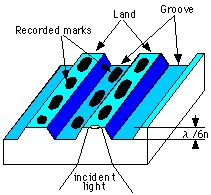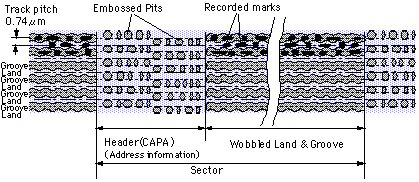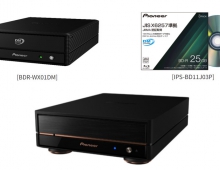DVD Technical Guide
22. DVD-RAM - Page 3
Review Pages
2. Concepts and Structure of the DVD Format
3. The Future of DVD
4. Design Concept of the Physical Specification
5. Features of the DVD Physical Specification
6. The DVD Data Format
7. Read-Only Disc File Format
8. Video Format
9. Video Format - Page 2
10. Video Format - Page 3
11. Audio Format
12. Audio Format - Page 2
13. Audio Format - Page 3
14. Audio Format - Page 4
15. Audio Format - Page 5
16. DVD-R and DVD-RW
17. DVD-R and DVD-RW - Page 2
18. DVD-R and DVD-RW - Page 3
19. DVD-R and DVD-RW - Page 4
20. DVD-RAM
21. DVD-RAM - Page 2
22. DVD-RAM - Page 3
23. DVD-RAM - Page 4
7.5 Land and Groove Format

The figure above shows a typical DVD-RAM structure. A DVD-RAM disc holds 2.6 GB per side (5.2 GB for both sides), or 4.7 GB (9.4 GB for both sides). This high recording density was achieved through the use of mark edge recording, along with the use of land and groove recording, which is effective for use with narrow track pitches. Previous optical discs used continuous groove recording, in which data is recorded only within the tracking grooves. Land and groove recording increases recording density by writing data both in the grooves and on the lands between the grooves. There is a limit to how much track pitch can be reduced as a means of increasing recording density, as narrow track pitch tends to weaken the tracking servo signal and increase crosstalk. The solution is land and groove recording. In phase change discs the groove depth is designed to be ![]() /6n, where
/6n, where ![]() is the pickup laser wavelength and n is the optical index of the substrate. This reduces crosstalk between the lands and the grooves, and allows conventional tracking signal schemes to be used with narrow track pitches.
is the pickup laser wavelength and n is the optical index of the substrate. This reduces crosstalk between the lands and the grooves, and allows conventional tracking signal schemes to be used with narrow track pitches.
The reduction in crosstalk with the land and groove method is a result of the fact that the reduction in reflected light due to interference with a neighboring track when in crystalline state is approximately the same as decrease in reflectivity when in amorphous state at a particular depth. That depth is about ![]() /6n, which is about 70 nm for a 650 nm laser wavelength.
/6n, which is about 70 nm for a 650 nm laser wavelength.
DVD-RAM uses this kind of land and groove recording, with a track pitch of 0.74 ![]() m (the same as in DVD-ROM) in the 2.6 GB version 1.0, and 0.615
m (the same as in DVD-ROM) in the 2.6 GB version 1.0, and 0.615 ![]() m in the 4.7 GB version 2.0.
m in the 4.7 GB version 2.0.
7.6 CAPA (Complimentary Allocated Pit Addressing)

The address signal uses a method called CAPA (Complimentary Allocated Pit Addressing) as a Physical ID (PID), and is recorded once per sector. In CAPA, the pits which record the PID are offset by one-half track from the data recording track (land or groove), to form a structure like that shown in the figure above. When groove tracking the address may be obtained from the CAPA signal behind, and when land tracking the address is obtained from the CAPA signal ahead. In each zone, the CAPA is aligned radially to allow CAV operation. The data recording area (land or groove) between each CAPA header is wobbled. Counting the number of wobbles allows the drive to accurately know the position of the next CAPA header.
Review Pages
2. Concepts and Structure of the DVD Format
3. The Future of DVD
4. Design Concept of the Physical Specification
5. Features of the DVD Physical Specification
6. The DVD Data Format
7. Read-Only Disc File Format
8. Video Format
9. Video Format - Page 2
10. Video Format - Page 3
11. Audio Format
12. Audio Format - Page 2
13. Audio Format - Page 3
14. Audio Format - Page 4
15. Audio Format - Page 5
16. DVD-R and DVD-RW
17. DVD-R and DVD-RW - Page 2
18. DVD-R and DVD-RW - Page 3
19. DVD-R and DVD-RW - Page 4
20. DVD-RAM
21. DVD-RAM - Page 2
22. DVD-RAM - Page 3
23. DVD-RAM - Page 4





















